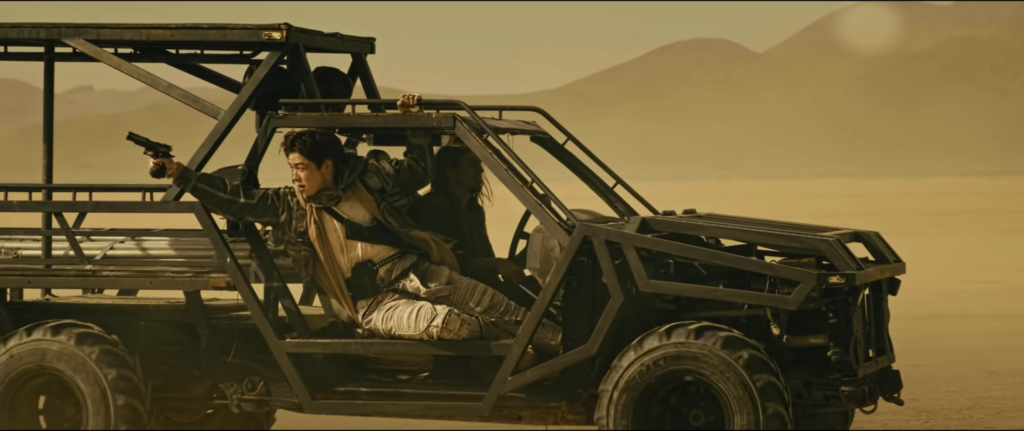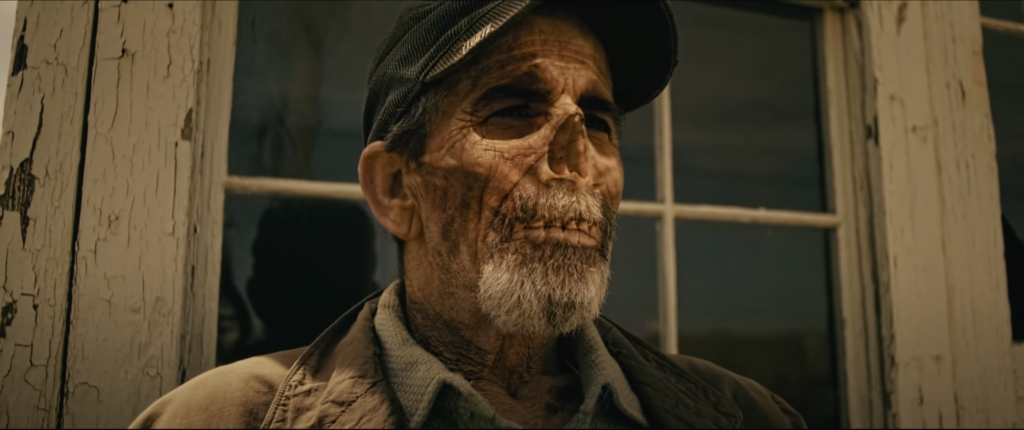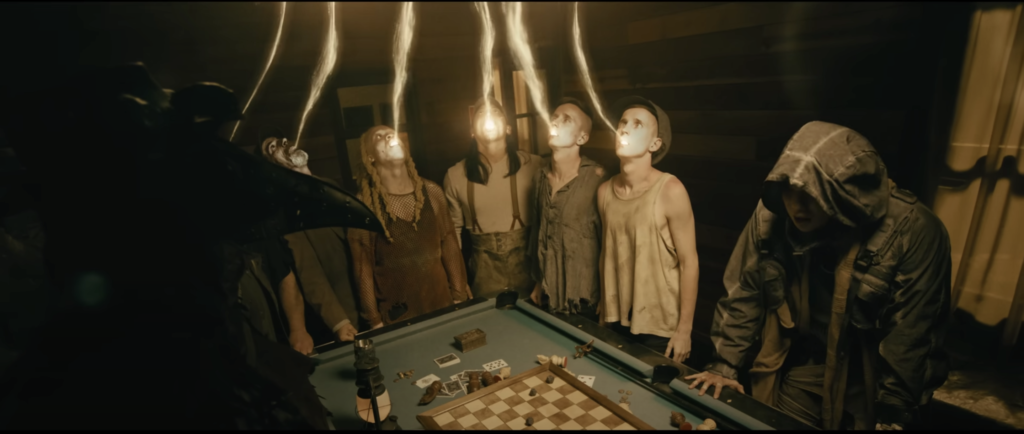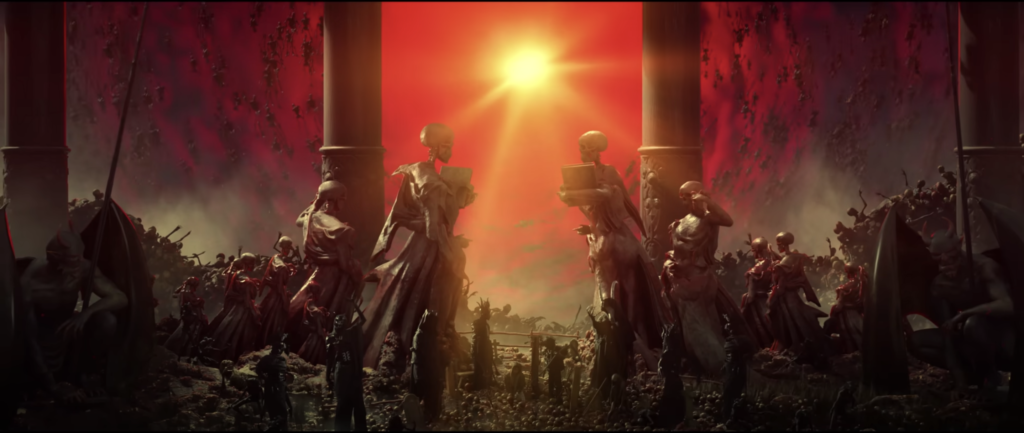
Promotions for Kang Daniel’s new album REALIEZ and its title track, a gritty rock and trap song called “SOS,” began with a “prequel.” Rather than using the language of traditional idol promotions (e.g. “teaser,” “mood sampler”), Kang Daniel’s marketing evokes the language of narrative, particularly cinema. In fact, the phrase “music video” may not suffice in describing the video for “SOS”: it is basically an accomplished dystopian action movie, complete with high-quality special effects, shootout scenes, and car chases. Depicting a story of a rogue Angel of Death through visual references to other films and his own pre-release videos, “SOS” brings epic proportions to the song’s cry for liberation from oppressive forces.
While previous songs like “Paranoia” (which bears similarity to “SOS” in its chorus) express Kang Daniel battling internal demons, “SOS” portrays him battling an amoral and deceptive external force. The video starts off with Daniel in a desert, isolated except for an abandoned boat and a cloaked figure who holds a gun to him. Daniel succeeds in shooting him first, and this is where the song begins in earnest. In the first verse, he states:
In this blackened place Corruption covered in a veil Every time I walk The darker it seems to get here
He travels through a world full of obstacles, implied to be progressively darker. Indeed, the threat of danger continues to build as the video continues. When he walks through a ramshackle town seemingly out of the Wild West, Daniel encounters other sinister beings: people who have skulls flash over their faces, suggesting some state between life and death. Shortly after the line “it’s too early to give up now,” Daniel chooses to enter a building, as the harmonies of the pre-chorus ascend and then drop to the punchy grunge rock guitar that launches the chorus.

In the chorus, he shouts, “I will break out even if it’s my last breath.” The storyline of the video heightens those stakes, as Daniel’s character engages in a shootout. It is an impressive, exciting sequence, as Daniel dodges blows from an attacker and dives to the ground to shoot another assailant lurking in the doorway. Set to vocal layering in the chorus, the scene compellingly dramatizes how Daniel is a solitary man striking back against immense power.
The drama of a loner battling a powerful group intensifies in another scene, in which the protagonist flees in a vehicle through the desert. This sequence continues to thrill, as the crunchy guitar and percussion grow more fervent, and Daniel shoots behind him, causing explosions as he destroys his enemies. It’s a sequence with obvious references to Mad Max, both in the costume and vehicle design, as well as the mere fact of staging a car chase through the desert. The visual similarities to that film also imply thematic ones: how a person claims humanity in the face of a barbarous and broken world.
In a recent video from Hello82, Kang Daniel played the “SOS” music video for fans, and they compared the aesthetic to Star Wars (in Daniel’s costume and in the desert landscape resembling Tatooine), and The Walking Dead (in the muted color palette and dynamic cinematography). Kang Daniel stated that his team took inspiration from The Kingsman for the shootout scene. “SOS” adopts a tried-and-true aesthetic of action films that contain elements of science fiction or fantasy but also draw upon tropes of Westerns. Rather than feeling cliché, though, “SOS” feels like it is depicting an archetypal hero’s journey.

In addition to drawing upon film references, Kang Daniel also establishes his own lore with the videos for REALIEZ. The day before the release of “SOS,” Kang Daniel’s YouTube page released an “Original Synopsis” video that explains the backstory of “SOS.” The video tells the story of a “man who was an Angel of Death” who begins to question the necessity of Hell. He disappears, then begins to kill other angels who hunt him down, collecting their coins that had the ability to “produce results… that deviated from the law of causation.” We see that the coins may revive the dead: in an early scene, man in the ground opens his eyes after Daniel tosses coins on his body, and in a scene with the people in the shootout, a flip of a coin seems to cause streams of light from their mouths seem to flow back in.
Some of the final sequences of “SOS” repeat imagery from two “music sequences” released for his pre-release song “Wasteland”: the first set in the desert, where Kang Daniel’s character is caught, and the second in Hell. “Wasteland” lingers on the Hell landscape, while “SOS” focuses slightly more on the end of the conflict: Hell being engulfed in a burst of light. The final scene seems to give closure to the stories of both “Wasteland” and “SOS” – Daniel walks alone in the desert, with a red explosion in the sky behind him, suggesting that he has destroyed the forces that are looking to defeat him.

With so many details that are difficult to decipher without the synopsis video, much of the viewer’s attention could be placed on piecing together the narrative rather than listening to the song itself. On the other hand, K-pop fans are largely accustomed to lore and storylines in music videos, and are rewarded for exploring all of the videos in the storyline.
Another possible downside of this music video is that its visuals and action sequences overwhelm the song, at least for the first few viewings. The sounds of gunshots and explosions dominate when they appear, giving the initial impression that the song is a background soundtrack for the video, rather than the video being in service of the song.
As a whole, however, Kang Daniel asserts himself as an ambitious and bold storyteller who, through cinematic production, angst-filled lyrics, and grungy riffs, deftly portrays a solitary hero battling a dystopian world.


